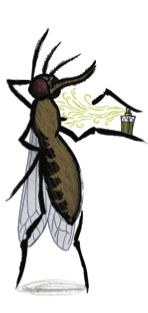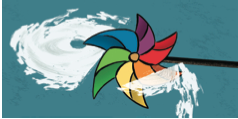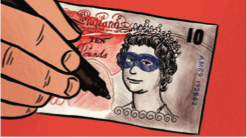MONDAY, 13 OCTOBER 2014
Eau de MalariaIt was proposed in the past that people and animals infected with malaria had a higher chance of attracting mosquitoes, but why this occurred was unknown. Research conducted in Switzerland and the US has revealed that malaria could be changing the odours emitted by a host by making alterations in the mixture of volatiles produced. Volatiles released by both infected and healthy mice for the duration of the malarial infection were collected, and gas chromatography and mass spectrometry used to identify the compounds that could augment the attraction toward mosquitoes. Interestingly, it was discovered that mosquitoes were only attracted to the infected mice during the contagious stage of malaria. It’s suggested that changing the host’s odour is essential for the parasite to complete its life cycle. Following infection, this consists of reproducing in the liver, spreading to the blood and then being consumed by mosquitoes (Anopheles), where they multiply in preparation for transmission to another host. Gametocytes (the blood stage parasites), are thought to be responsible for changing odour profiles. If this relates to humans infected with malaria, it may be possible to recognise malarial infections in people that are yet to show symptoms. Rachel Harvey
Turbines Perturb Hurricanes
Mark Jacobson, a Professor of Civil and Environmental Engineering at Stanford, has been doing research on hurricanes and environmental engineering, assessing what effect a large wind farm would have on a hurricane’s power. As part of his research, he developed a model which simulates hurricanes. He then developed the model further and simulated what might happen if a hurricane encountered an enormous wind farm stretching for many miles offshore and along the coast. Incredibly, he found that the wind turbines could disrupt a hurricane enough to reduce wind speeds by up to 92 miles per hour and decrease storm surge by up to 79 per cent. Using the case of hurricane Katrina and Jacobson’s model, he found that the 78,000 wind turbines off the coast of New Orleans would have weakened the hurricane. In the computer model, by the time Katrina reached land, its wind speeds had decreased by 36-44 metres per second and the storm surge had decreased by up to 79 per cent. It’s safe to say wind turbines save money and lives! Brandon Bedford
Starch Contrast
Counterfeit money is becoming a growing problem in today’s society, with the majority of this problem being caused by fake bank notes being found in circulation. There are many different ways that a fake bank note can be identified; one of the most instantaneous and effective tests is to use a Counterfeit Banknote Detection Pen. The concept itself seems fairly complicated, however the test is very simple to carry out and can be easily explained. The ink of the Counterfeit Banknote Detection Pen contains iodine, which reacts with the starch in the wood used to make conventional paper, leaving a blue-black stain. However, the paper used to make bank notes does not contain this starch-based wood and instead is made up of a fibre-based paper. As such, no reaction occurs when a line is drawn. When the starch reacts with the iodine, a starch- iodide complex is formed. The negatively-charged electrons pass a charge from the iodine ion to the starch, causing the colour change in the solution to occur. The original orange colour of the iodine turns blue-black. This reaction is what shows the presence of starch on the banknote, therefore identifying whether it is genuine or not. Ellen Rugg



